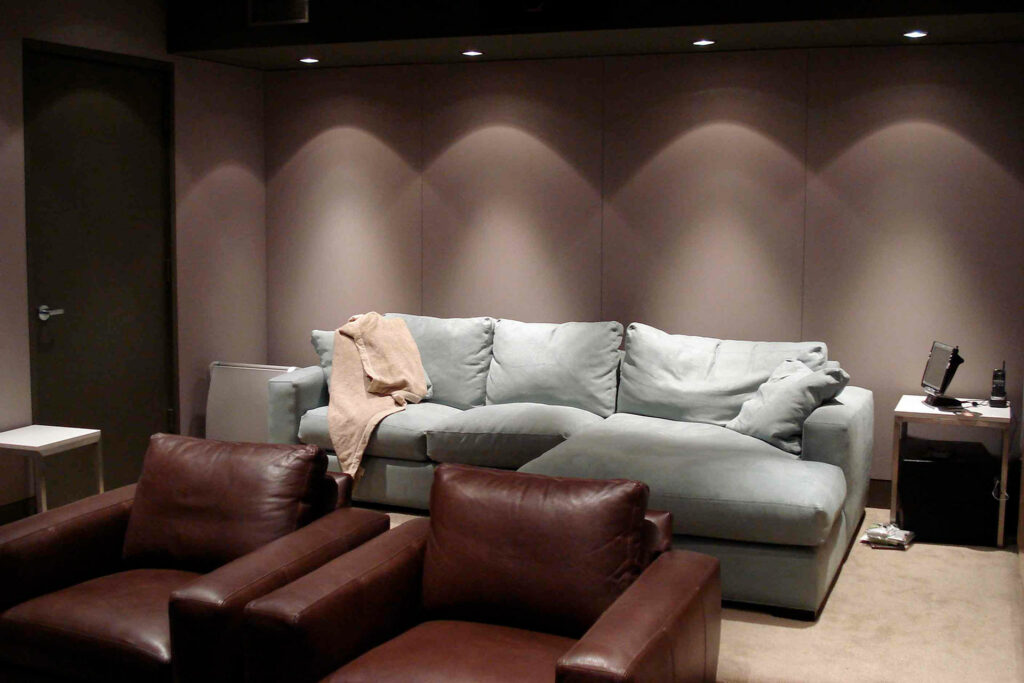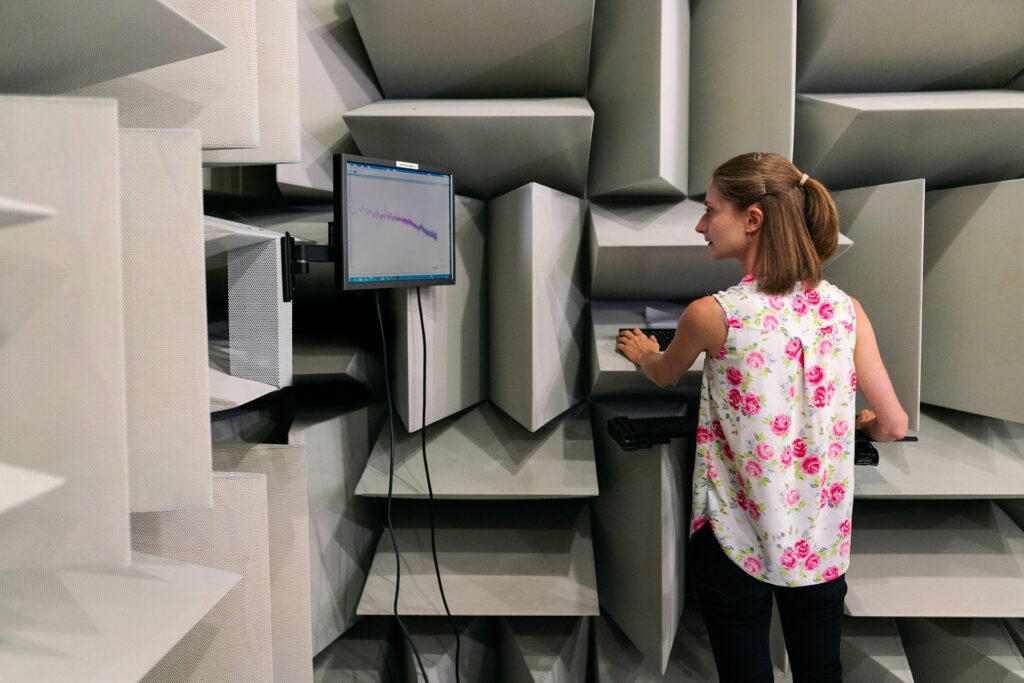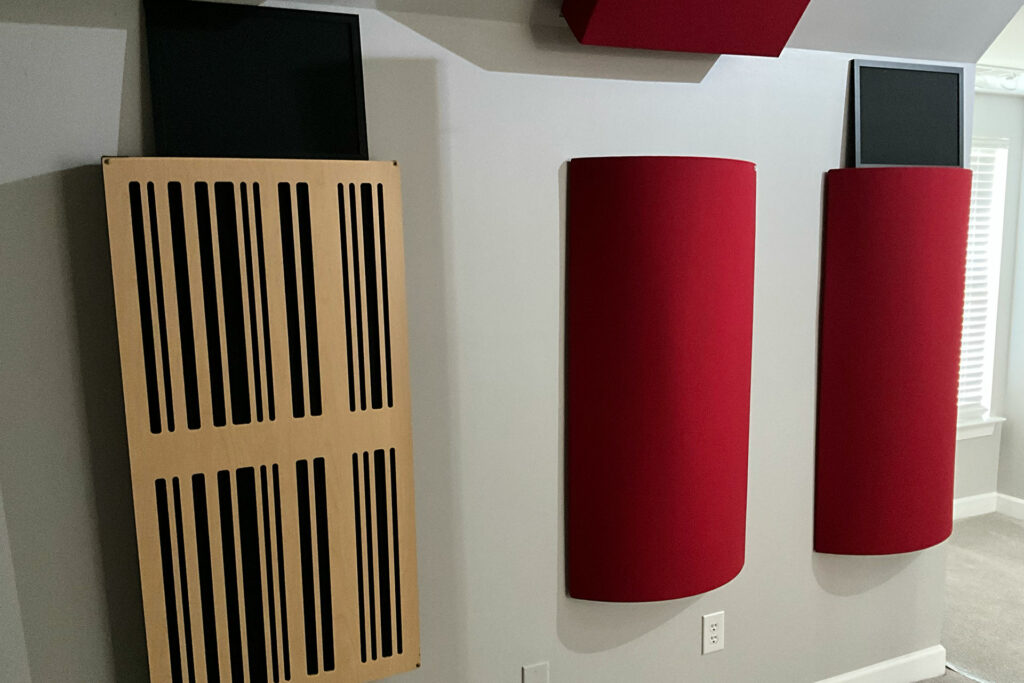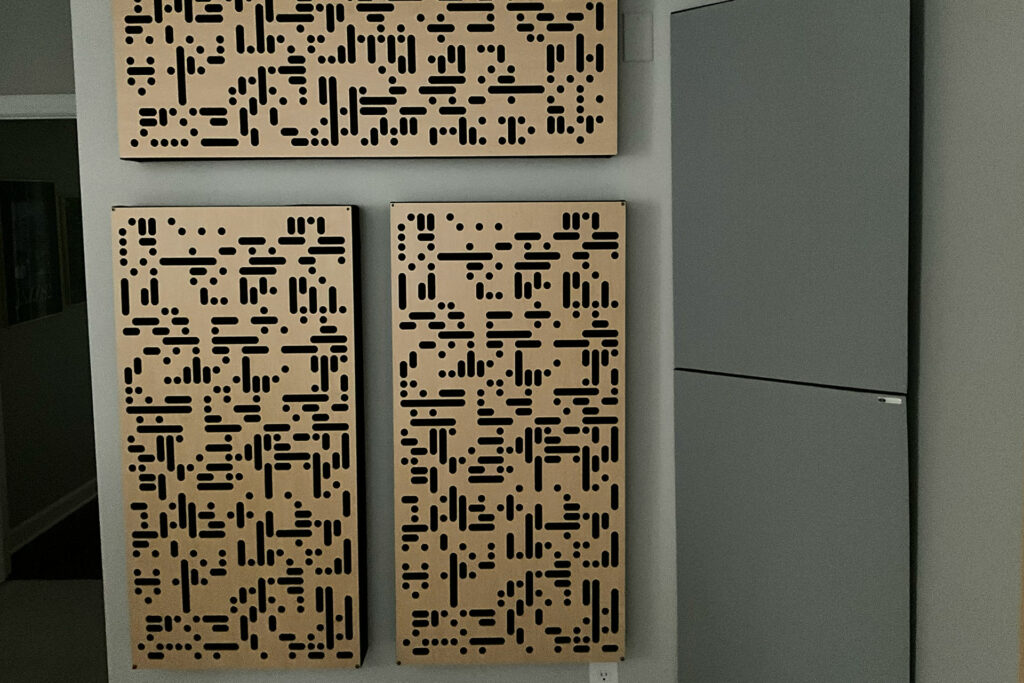For most audiophiles, the road to sonic nirvana often follows the path of increasingly better equipment. Many of us spend decades and untold thousands of dollars replacing an existing something for a something better – all in the hopes of an improved sonic picture. All too often, one’s listening room (check out Paul Wilson’s $500,000 system here) is mostly ignored or even forgotten completely.
Oddly enough, optimizing the room where the system resides may offer a sonic improvement on par with, and often even better than a very expensive new audiophile component. Very often, changing the room to yield better sonics happens for free or for very little cost.

I’ll be working from the assumption that you have a dedicated audio room, but any of these suggestions can be modified to accommodate situations where the audio system is housed in a family room, for instance. This article’s main purpose is an introduction to room acoustics; much more detailed information may be found with an Internet search depending on how deep that you want to dive into any one of these topics.
Play the System, Hear the Room
This inviolate wisdom essentially defines our goal of achieving that nth degree of sonic perfection. In all cases, the room is a principal composite of the sonics the system will produce. Our goal, therefore, is to make the room work in our favor and help the system deliver the finest auditory experience possible.
Get To Know Your Specific Audiophile Listening Room
Most audiophiles are forced to put their system in a room not especially suited for the purpose. Generally speaking, for a two-channel audiophile system, a rectangular room is better than a square room. It is also typically recommended to place the speakers and listening position on the short wall. Most audio systems are also placed on the short wall. However, placing the system on the long wall and the speakers on the short wall is also recommended.
Take measurements of your room to understand how the room was built. Sadly, most rooms are not constructed with parallel or even plumb walls. In my audio room, the long walls are not parallel and the front section of the right wall, smack dab in the area of image development, is slightly canted forward past plumb. This caused reflection problems requiring a modification in how I positioned my speakers. That’s likely not a specific issue in your room, but you likely have your own issues and it is important to know them so you can accommodate for them.

What Is the First Step in Getting the Room Right?
Optimal loudspeaker placement is perhaps the best place to start when considering how the room affects sonics. All speaker setup procedures are a starting point. Sonic performance is room dependent so a logical first step to create an equilateral triangle when measuring the distance from one speaker to the other one and both to the listening position. Finely tuned speaker adjustments may be made from there to achieve the best sound. And don’t be surprised if fine tuning means increments of a few millimeters at a time.
If using dynamic speakers, which most audiophiles will use, the closer the speakers are to the front wall (the wall you face when sitting in the listening chair), the more powerful the bass will sound. This will also yield a reduction in image depth. Moving the speakers further from the front wall increases the image depth but can reduce the bass response. It is therefore the listener’s preference of how far into the room the speakers are positioned. Other speaker types, such as planar and electrostatic, have their own specific requirements. Knowing the optimal positioning and image development of a specific speaker design is therefore advisable. Trial and error is also encouraged at this stage.
Some Speaker Setup Tips
This is a highly contentious topic and one ultimately described as personal preference, but there is a lot of basic science that needs to be considered before getting personal. Our first speaker placement method is the Rule of Thirds. Basically, this method divides the room into thirds measured by the room’s longest dimension. The speakers are placed on the first third, the listening position is placed on the second. Remember to begin placement in an equilateral triangle and adjust from there in small increments.
Another popular method is the Cardas Setup Method. This approach uses the room width and basic math to obtain a recommended speaker placement. It also has placement formulas for several different types of rooms and speaker designs. I have used this method, again as a starting point, and found it to be an effective first step.
There are so many options and recommended setup procedures that it’s easy to become overwhelmed. It is therefore important to remember that any of these placement methods are a starting point and you can work from there. The final and ideal speaker position will be based on micro-adjustments, your specific room, and what sounds best to you. Never forget: you are the boss and this room is designed for you to get the sound that you want.

How to Deal with Sonic Reflections in an Audiophile Listening Room
When sound waves leave a speaker, some will directly reach the listener’s ears with no physical interruption. Others reflect around the room before arriving at the listening position, causing all sorts of potential sonic issues. Depending on how the room reflects or absorbs bass, midrange, and treble, certain instruments may be affected. If treble sounds are adversely impacted, a cymbal crash may be far less noticeable. Bass sounds may actually be muted or reinforced depending on what happens to them. When a directly radiated sound combines with a slightly delayed reflected sound, the result of what we hear is called comb filtering. It is the combination of reflected and directly radiated sound. Comb filtering may cause phase differences between the two signals, which may lead to diminished sonics.
When a sound is reflected off a surface once and then reaches the listener’s ears, this is called a first order reflection. This is a great place to start working on your room treatments, as first order reflections are normally on the side walls, the ceiling, or even the floor (this is audiophiles often loathe coffee tables) about three feet in front of the speakers. These room anomalies may easily cause your sonics to sound muffled or unclear. Wall- and ceiling-mounted acoustical panels are typically an effective way to negate unwanted reflections and comb filtering. It is worth remembering reflections may come from any surface in the room: walls, floors, ceilings, furniture, framed art, TVs – any surface. All of these serve to degrade the quality of the sound our systems produce.
Generally speaking, in a dedicated audiophile listening room, a minimalist approach is usually best. Removing every possible piece of unneeded furniture will yield a better sonic result (sorry, Shabby Chic folks). It should be noted that imaging simply cannot take place where furniture sits. So the large cabinet against the wall, or the glass top coffee table between the listener and the speakers, will physically degrade your sonics. It is just simply physics. Obviously, this is room dependent as to the severity, and we all live in the real world, so compromises will have to be made in every audiophile listening room. Make sure your listening room looks like a respectable part of your home’s overall design aesthetic, even if it means giving up on a few possible acoustic advantages, as the overall success of the room is in the experience, not some graph or measurement.

What Do Acoustic Treatments Do and Why Should You Care?
If our goal is to manage reflected sound, there must be a method to do so. Audiophile-grade room treatments are a great first step to treating your listing space. Basically, this is a physics experiment, because sound is effectively energy, and energy cannot be destroyed, as stated in the Laws of Conservation of Energy, so reflected sound in an audio room must be converted to a different form to be managed.
Acoustical treatments are actually designed to convert sonic energy to heat. This is done by increasing the kinetic energy of the sound wave passing through the room treatment. The material inside the panel, typically foam or a softer insulation material, is designed to slow down the signal, raise the signal’s temperature, and convert it to heat, which is harmlessly dissipated. The reflected sound is therefore eliminated, which improves the sonic character. Room treatments are usually very effective when used properly. It is always advisable to work with a company or individual who may provide assistance in designing an effective room treatment solution. Note: most acoustical treatment companies are willing to help you with a plan to treat your room, giving you quite a bit of free advice assuming you plan to buy some of their products.
Acoustical panels differ in type pretty significantly. Absorption panels will absorb almost all energy passing through them. They vary in size and shape and are usually hung on a wall and/or ceiling. Reflection panels are used when it is necessary to reflect the sound. This may be to accentuate a higher frequency so it is more noticeably perceived. Combination panels both absorb and reflect.
To help correct congested-sounding, boomy bass, a treatment called a bass trap may be used. Bass tends to get stuck in corners, which causes lows to sound bloated. Corner traps and/or other bass eating treatments like tube traps help eliminate this issue. Bass frequencies have long wavelengths (a 30Hz tone is almost 38 feet in length) and can be very difficult to control in most rooms. Bass traps help bass to not get stuck in a corner. Hiding bass traps in your drywall bays is the least invasive solutions, but is a bit of a messy construction project and likely needs a fabric wall to cover the installation. Standalone bass traps can be both wide and tall as well as ugly. Using big plants (good for diffusion) can help hide these tacky looking but far more affordable bass traps. The aforementioned corner traps are effective but not nearly as good looking as the installed option such as an RPG Modex Plate.
Not limited to purpose-built panels, walls may be treated with draperies and curtains. Heavy drapes with lots of pleats are often surprisingly effective. Floors are best covered. Rooms with tile or wooden floors will create significant reflections. Carpet is the best choice but even a thick rug covering a hard floor between the speakers and listening chair will help. Bookshelves may possibly assist in reflecting sound due to unevenness, but how effective bookshelves are in regard to sonic improvements is debatable.
In the case of windows and exterior glass doors, it is highly advised to cover them with drapes or curtains if possible. All glass is highly reflective. If you face your system when sitting in the listening chair and have a large TV hanging above the stereo, remember it is a huge source of reflections leading to comb filtering (maybe consider having an absorptive cover made for your TV by a local seamstress). Here is a You Tube video from GIK Acoustics showing the difference between an untreated and an acoustically treated room.
What Are Standing Waves and How Do They Effect an Audiophile Listening Room?
Standing Waves occur in all rooms and are specific points where positive and negative sound pressure converge and become stationary. These waves may be both constructive or destructive. They are created when direct sound of one pressure wave combines with reflected sound of the opposite pressure wave. When two waveforms with positive pressure combine, the signal is reinforced. This is a constructive wave and may result in stronger bass response. Often it may be too strong.
When one waveform with positive pressure meets one with negative pressure, the two signals cancel each other out, producing a destructive wave. This is also called a null point. Audiophiles sometimes humorously call this bass suck out or the whooshing sound occurring where bass should be (but is not). Once heard, this sound is unforgettable. This is a very complex subject and there are many informative and highly detailed articles on the Internet on the cause and remedy of this sonic condition.

What Is Digital Room Correction and How Might It Help?
Sometimes used as an alternative, but ideally used in conjunction with acoustical panels is Digital Room Correction (DRC). Where room treatments manage sound waves in the room after leaving the speakers, DRC manages the sound before the signal ever reaches the speakers. This process has become much simpler in recent years to incorporated into a two-channel system.
Basically, what room correction does is measure the frequency range, from the lowest to the highest, and alter the signal to achieve a more flat frequency response before the signal leaves the amp. Typically, a test CD or digital file will play pink noise or specific test tones at individual frequencies. A microphone connected to the unit is then moved around the room to take readings. These readings are then used to create a specific filter to alter the music signal to better project a flat frequency response. This is done by complex algorithms built into the DRC device. Sometimes, DRC will be incorporated into a stereo preamp, a standalone audiophile component, or an AV preamp, if we are talking about the home theater world. It is now even possible to find room correction on powered speakers and especially with audiophile subwoofers. DRC is a very effective way to smooth out frequency dips and peaks in any audio room.
Room correction may be an excellent method to tame undesirable and overwhelming bass or highs that are hardly recognizable. This is particularly true with cymbals and high hats, which may easily get lost. Room correction may be a saving grace if the audio system is housed in a family room and acoustical panels and bass traps cannot be used, but it is always better to physically treat your audiophile listening room first before using digital solutions.
Perhaps the most effective room treatment is using acoustical panels and digital room correction together. Room correction has traditionally been most effective in the frequency domain, whereas physical panels on the wall work in the frequency and the time domain. That said, in the recent past, DRC has made progress, although some question the actual effectiveness, in accommodating the time domain in addition to frequency domain.

Speaker Setup Is Dependent on Highly Accurate Dimensions
Our ear/brain system is a marvel at providing an aural representation of the world around us. We principally hear and process sound in three distinct ways. One, we process sound in terms of amplitude, or how loudly or softly we perceive what we hear. Second, we process sound in terms of frequency, or how low in bass tones as well as how high in treble tones we hear. Sadly, as we age, these two metrics change and not usually for the better. Lastly, and perhaps most complex, we process sound in terms of time alignment.
Everyone is familiar with thunder. We’ve all heard the rumbling it makes. If you have ever heard thunder sound like it is right above your home you can easily tell it is very close. Hearing thunder sound as if it is a long way away also occurs. And when it does sound distantly far away, the direction from which the sound arrives may also be easily discerned. It is almost an involuntary response. Why?
Time alignment in our auditory process is the time it takes for sound to reach one ear as opposed to the other ear. It is estimated our ear/brain mechanism is capable of distinguishing the difference of time alignment down as low as one millisecond or less. This is why we can tell how far away thunder is and also its directionality. It explains why we can hear where performers on a stage are playing, especially with acoustical music. It is how we are able to distinguish imaging in a listening room. And whadda-ya-know, it is also one aspect of what our stereo systems are designed to recreate.
In any listening room, certain things are fixed and others are variable. The speed of sound in any room, at a given barometric pressure and altitude, is fixed. Walls are fixed. Our only variables are where the speakers reside and what is contained in the room, such as furniture. Because of the fixed conditions, when sound is reflected, it does so on a very specific path. Angle of reflection and angle of incidence are at work here. Change any of the variable conditions, such a moving a speaker or a piece of furniture, and the reflected sound is also altered.
Because our ear/brain does so remarkable of a job in processing sound, and time alignment is so exactingly precise (and best of all doesn’t deteriorate with age), we can tell very subtle differences in the imaging our systems produce. Moving a speaker in any direction even a few millimeters changes the angle of reflection and therefore the time signature of what we hear. I suspect this is difficult for non-audiophiles to understand. They typically position speakers for aesthetic reasons, not for sonic ones. It is therefore important to make macro adjustments in speaker position but also make micro adjustments to really dial in the exact placement for the best sonic picture.
Conclusion
It is important to remember to make the room’s acoustical signature an important part of the overall audio system’s setup. Knowing what an individual room does to an audio signal may help prevent a catastrophic reduction of the quality of the music we all want to hear and enjoy.
This is a very complex subject, intermingled with all sorts of physics and other science. What is perhaps best is how a small change in a speaker’s positioning may provide a surprising sonic improvement. Understanding and tweaking the room’s particular sonics will usually lead to an enriched musical experience. Improved listening is exactly what the hobby is trying to create, so when a properly treated and set up room is combined with quality electronics and a great recording, the result can be absolutely stunning. Perhaps best of all, in many cases, room optimization is usually free.
In the third installment of audio basics, we’ll take a deeper dive into the most popular speaker types, how they work, and the pluses and minuses about each.




Excellent article, especially the emphasis on speaker placement. This summer I decided to accept my left ear hearing loss & re-orientate my speakers on the right side of the room towards the corner. I tried several different locations & listened to acoustic bass & sure enough I could hear room several modes at the sitting position, that were not there before. Luckily the final placement did the trick. Later I added a subwoofer between the speakers & it added a pleasant foundation to the music. Next I should experiment with removal of the coffee table but where to put the frequently used stuff (coaster, remotes & tablet?). Experimentation pays huge dividends!
The speaker locations are important but so is the listening position. It should not be located close to a wall, that never sounds good. It, too, is better located out into the room. Good luck!!
Thanks for your always excellent comments – Trevor!
Trevor,
Many thanks for your very kind words. I have always found it amazing how moving speakers in such small increments can make such a pronounced sonic difference. Seems to confirm there is a lot more going on with our rooms than we realize!
As to a place to put the coster and a glass, I got two really small round tables from Wayfair. When I say small, they are only about 6″ across the top. It is the perfect height to sit a glass or something else on. I have my iPad on one and a couple of remotes on the other. When guests come over, I clear everything to make room for a wine glass or something similar. I have two of these small tables, one on each side of my listening chair. Best of all, they are small enough to not cause any sonic problems. None that I can tell, anyway.
Happy Listening,
Paul